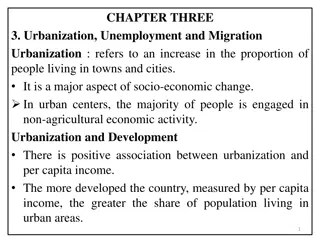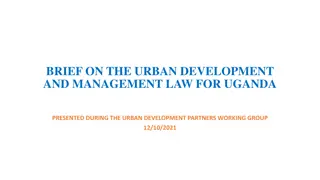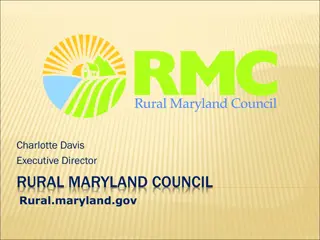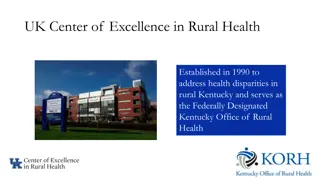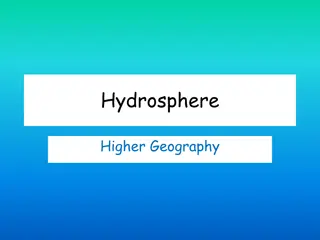Contrasting Urban and Rural Hydrographs
Hydrographs in urban and rural areas exhibit distinct characteristics due to differences in land use and infrastructure. Urban hydrographs typically display steeper rising and falling limbs, shorter lag times, and higher peak discharge rates compared to rural hydrographs, which have gentler slopes and longer lag times. Factors such as impermeable surfaces, rapid overland flow in urban areas, and natural processes like infiltration and transpiration in rural settings contribute to these contrasting hydrograph patterns.
Download Presentation

Please find below an Image/Link to download the presentation.
The content on the website is provided AS IS for your information and personal use only. It may not be sold, licensed, or shared on other websites without obtaining consent from the author. Download presentation by click this link. If you encounter any issues during the download, it is possible that the publisher has removed the file from their server.
E N D
Presentation Transcript
Lesson five: Urban and Rural Hydrographs Learning intensions: We are learning about the hydrosphere. Success criteria: I can describe the differences between a rural and urban hydrograph. I can account for the differences between a rural and urban hydrograph.
Starter Urban or Rural? You will be given a number of statements and have to decide if they apply to an urban or rural hydrograph. Make your thoughts clear by moving to the door for RURAL, and the window for URBAN.
Urban (window) or rural (door)? 1. Shorter lag time 2. Steeper rising limb 3. Gentle falling limb 4. Overland flow 5. Precipitation falls onto leaves then drops onto ground 6. Will take longer for river to return to base level
Urban and rural hydrographs Hydrographs can look very different depending on the environment of the drainage basin. Urban hydrographs have steeper rising and falling limbs, whereas rural hydrographs have more gentle rising and falling limbs.
Urban and rural hydrographs On page 9 in your booklets you have summaries of the two hydrographs. You are often asked to compare the two graphs and then provide reasons for the differences. This means that in your answers you must use phrases such as compared whereas . to , and
Urban Rural Shorter impermeable surfaces e.g. tarmac lead to rapid overland flow resulting in quick transfer of water to the river. basin lag time = Longer Precipitation (interception) and then drops to the ground (stem flow). Some will infiltrate and therefore take longer to return to the river. basin lag time = falls onto leaves Steeper management systems such as gutters and drains allows water to flow into river quicker leading to high peak discharge. rising limb = Water Gentler rising limb = Moisture can also be absorbed and transpired by trees so less water reaches the river. Steeper falling limb = There is less underground storage of water so the vast majority of the water will have entered the river and the base level will return quicker because there is not any more water to add to it. Gentler falling limb = Water will return to the river after many hours as it flows through soil and rocks as groundwater flow This further results in the river taking longer to return to base level.
Task 5 Past Paper Question Page 12 Accountfor the differences between the urban and rural hydrographs shown in the diagram following a heavy rainstorm. (8) The urban hydrograph has a shorter lag time compared to the rural hydrograph because... Remember to use terminology such as infiltration etc.
Structure 1. Urban steeper rising limb due to gutter and drains high peak discharge. 2. Urban shorter basin lag time due to increased overland flow from impermeable surfaces. 3. Rural longer lag time due to interception and stem flow. 4. Rural gentle rising limb (and lower peak discharge) due to absorption and transpiration. 5.Rural gentle falling limb due to throughflow (soil and rocks).
Perfect answer The urban hydrograph has a steeper rising limb compared to the rural as water enters the river quicker via gutters and drains, leading to a high peak discharge. The urban hydrograph has a shorter basin lag time as water flows over impermeable surfaces such as tarmac, and therefore enters the river quicker as a result of rapid overland flow.
The rural hydrograph has a longer basin lag time compared to the urban hydrograph because some of the water can be stored through interception when precipitation lands on the leaves of the trees, or can run down the branches and trunks via stem flow, slowing down the time it takes for the water to enter the river. The rural hydrograph has a more gentle rising limb compared to the urban hydrograph (and therefore a lower peak discharge) as some of the water does not reach the river as it is absorbed by the roots of the plants and then transpired out into the atmosphere.
The rural hydrograph has a more gentle falling limb compared to the urban hydrograph because water will keep returning to the river after many hours as it flows through soil and rocks as groundwater flow. This further results in the river taking longer to return to base level.
Homework Page 1 of your booklet. 1. Explain the global hydrological cycle. You may wish to draw an annotated diagram. (8) 2. Suggest how human activities such as those written below can impact on the hydrological cycle. (6) Deforestation, Irrigation, Dam building, Reservoirs, Urbanisation and Mining. 3. Accountfor the differences between the urban and rural hydrographs shown in the diagram following a heavy rainstorm. (5)
Success criteria I can describe the differences between a rural and urban hydrograph. I can account for the differences between a rural and urban hydrograph.
Plenary Label the hydrograph 3 1 4 2 5






